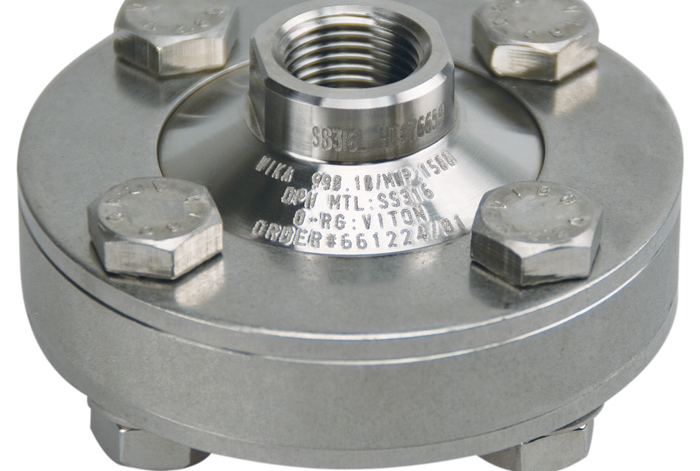
The right size diaphragm seal is an important consideration when selecting to protect your expensive pressure measuring instruments. Size in this case does not refer to the external dimensions of the diaphragm seal device, but to the size of the internal flexible diaphragm seal that transfers the pressure from the process media to the fill fluid. (The fill fluid then transfers the pressure to the instrument for reading.)
A Diaphragm Seal Must be Big Enough to Get the Job Done
A diaphragm seal must be big enough to displace a sufficient volume of fill fluid to drive the pressure gauge or transmitter through its full range. This means that pressure instruments measuring relatively high pressure ranges can use small diaphragm seals, but those measuring lower pressure processes need larger diaphragm seals to create enough flow to take the instrument to the top of its range. Something to keep in mind is the lower the pressure range, the larger the diaphragm seal needs to be. That is a good rule of thumb because lower pressure systems require the greater volume displacement of a larger diaphragm to create sufficient displacement to drive the system. By the same token, smaller diaphragms (lower volume displacement) are usually sufficient for higher pressure applications. A corollary to the rule of thumb above is the larger the gauge, the more displacement is needed by the diaphragm to drive the system. By the same token, smaller gauges are generally preferred for low pressure applications. The general rule of the lower the pressure, the larger the diaphragm required and vice versa applies to diaphragm seals used with pressure gauges or pressure transmitters.
Using Larger Diaphragm Seals can Increase Measurement Accuracy
Another important consideration is that the use of a smaller diaphragm seal on a relatively low-pressure process will lead to less accurate measurement. For example, in a relatively low-pressure application using a 1.5-inch diaphragm seal on a pressure transmitter used to measure the liquid level of a tank, your error would be as high as 12.1 inH2o. If you move up to a 2-inch diaphragm seal, your error drops all the way to 1.7 inH2O; and if you use an extra-large 3-inch seal, you will have a mere 0.5 inH2O error. The size of the seal is just one of a number of important factors to consider when choosing a diaphragm seal to protect your instruments. Give the pressure gauge and transmitter experts at WIKA a call and let us walk you through the diaphragm seal selection process. We’ll make sure you’ve got the right instrument and the right seal for the job. WIKA: We’re Not Just Pressure Gauges. #expertinstrumentation #diaphragmseals #PartofYourBusiness


Dear Sir,
I want to select the process connection size of our flanged diaphragm seals. Generally two types are considered in our project (2″ and 3″ flange). Would you please guide me in which numerical conditions I should select 2″ or 3″ flange size?
Thanks in advance.
Hi,
Thank you so much for the question! When you say 2” and 3” flange, you are referring to standard flange sizes set by ASME B16.5. Usually, the ASME B16.5 flanges are notated by 2 numbers, an inch size, and a “pound rating”. For example, a flange can be 2”-150 lb or 3”-600 lb. WIKA offers flange sizes and connections from ¾” to 4” and 150 lb-2500 lb. The inch size tells you about the size of the pipe that you are connecting the flange too. For example, if you have a 2” pipe, then you will use a 2” flange. The lb number indicates the pressure rating of the flange. A 2”-150 lb flange has the same pressure rating as a 3 or even 4” -150 lb flange, but the maximum working pressure for 150lb flanges is actually 275 PSI and 300 lb flange is 720 PSI. The combined inch size and pound rating tells you the outside diameter, the bolt circle, thickness, and even the connection type and size. I hope this helps if you have any other questions please feel free to contact us again!
Best Regards,
Chi-Che Ma
Product Manager – DS